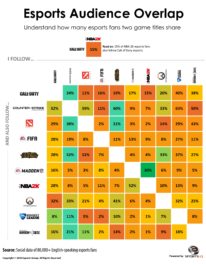The global esports experience continues to grow. According to Newzoo’s 2020 Global Esports Market Report, the total esports audience will grow to 495 million in 2020 – a year-over-year growth of +11.7%. Growth which represents increased opportunity to engage fans and attract sponsors.
However, esports remains an umbrella term – covering competitive play across multiple game titles. And the structure present in traditional sports, which makes it easy for marketers to understand their audience across several dimensions, does not easily apply to competitive video games.
Additionally, gaming forges unique social connections which are essential to leveraging the unique opportunities in esports marketing. The games people follow reveals who they are, how they see themselves, and where their passions lie.
And esports audiences are reflective of the interests and social connections native to the game communities from which they originate. To understand as much, here’s a look at how closely related competitive gaming fanbases are (click image to enlarge):

Key takeaways
- League of Legends only shares an average of 20% of its esports audience with other titles – despite worldwide popularity. A figure which points to a fanbase with a high rate of single game loyalists.
- Sports simulation games (Madden, NBA 2K, FIFA) share 4 times more of their competitive audiences with each other than with other game genres
- Rocket League has the highest average esports audience overlap (29%)
- Dota 2 esports fans are more than 2 times likely to follow League of Legends than vice versa
- Half of the titles, which share 50%+ of their esports audience with at least one other game, are in the shooter genre (CSGO, Call of Duty, Rainbow 6).
